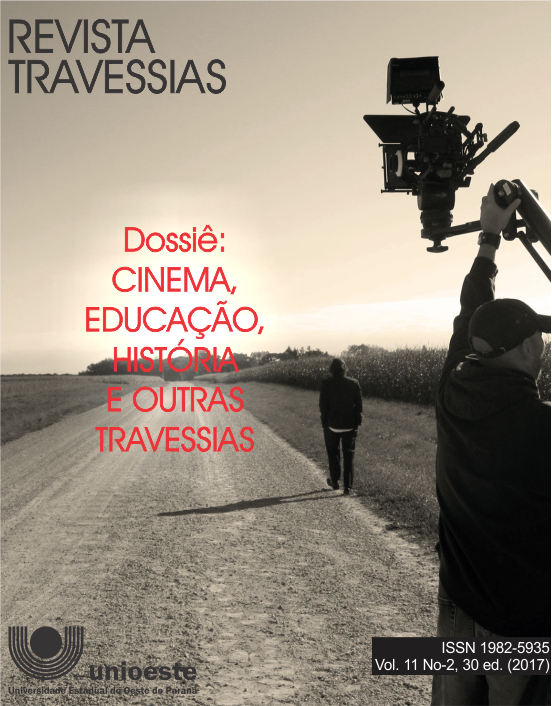Analysis of the other voice in light of a discourse perspective.
Keywords:
Clear and Disguised Voice, Literary Discourse, Bakhtinian Discourse Perspective.Abstract
Someone else’s voice is present in our daily talking, in the rhetorical way of saying, and in literary discourse. From a bakhtinian dialogic polyphonic perspective (1992; VOLOCHINOV, 1981), this paper aims to identify and understand whereby someone else’s discourse, either clear or disguised, according to Authier-Revuz (1982, 1998), is manifested in the literary way of saying, more specifically, in chronicles. We selected two chronicles published in a Brazilian newspaper, namely Zero Hora, aiming at analysing how someone else’s voice under discourse linguistic strategies is manifested and how his or her sense effects are realised textually. We investigated how free indirect, indirect, and direct discourses work, considering other indicators, whether marked or not, by relating them to the transmitter’s way of saying, which at the same time seeks for bringing closer, and moving away from someone else’s voice, depending on the semantic effect that intends to conveyDownloads
References
AUTHIER-REVUZ, J. Heterogeneidade mostrada e heterogeneidade constitutiva: elementos para uma abordagem do outro no discurso. In: DRLAV (Documentation et Recherche en Linguistique Allemande-Vincennes), n.26, Paris, 1982.
______. Palavras incertas: as não-coincidências do dizer. Campinas: UNICAMP, 1998.
BAKHTIN, M. Estética da criação verbal. São Paulo: Martins Fontes, 1992.
BAKHTIN, M.; VOLOCHÍNOV, V.N. Marxismo e filosofia da linguagem. Tradução de Michel Lahud e Yara Frateschi Vieira. São Paulo: Hucitec, 1981.
BRAIT, B. Estilo. In: BRAIT, B. (org.) Bakhtin: conceitos-chave. São Paulo: Contexto, 2005, p. 72-102.
______. (Org.) Bakhtin: outros conceitos-chave. São Paulo: Contexto, 2006.
CRUZ, S.A.C. e COSTA-HÜBES, T.C. Gênero discursivo crônica: aspectos temático, estilístico e composicional nas práticas escolares. Travessias, v.10, n.03, p. 25-40, 2016.
FARACO, C. A. Linguagem e diálogo: as idéias lingüísticas do Círculo de Bakhtin. São Paulo: Parábola, 2009.
FIORIN, J. L. Intertextualidade e interdiscursividade. In: BRAIT, B. (org.) Bakhtin: outros conceitos-chave. São Paulo: Contexto, 2006, p. 157-193.
RODRIGUES, R. H. Os gêneros do discurso na perspectiva dialógica da linguagem: a abordagem de Bakhtin. In: MEURER, J. L.; BONINI, A.; MOTTA-ROTH, D. (orgs.) Gêneros: teorias, métodos, debates. São Paulo: Parábola Editorial, 2005, p. 152- 183.
SCLIAR, M. Gafes. Zero Hora, publicado em 11-11-2003.
SOBRAL, A. Ver o texto com os olhos do gênero: uma proposta de análise. Bakhtiniana, São Paulo, v. 1, n. 1, p. 85-103, 1º sem. 2009.
VERISSIMO, L. F. A Proposta. Zero Hora, publicado em 17-11-2003.
Downloads
Published
How to Cite
Issue
Section
License
Creative Copyright Notice
Policy for Free Access Journals
Authors who publish in this journal agree to the following terms:
1. Authors keep the copyright and grant the journal the right of first publication, with the work simultaneously licensed under the Creative Commons Attribution License, which allows sharing the trial with acknowledgment of authorship and initial publication in this journal.
2. Authors are authorized to take additional contracts separately, for non-exclusive distribution of the work version, published in this journal (eg publish in institutional repository or as a book chapter), with acknowledgment of authorship and initial publication in this journal.
3. Authors are allowed and encouraged to publish and distribute their work online (eg in institutional repositories or on their personal page) at any point before or during the editorial process, as this can generate productive changes, as well as increase both impact and citation of the published trial (See The Effect of Free Access).
Creative Commons License
This work is licensed under a Creative Commons Attribution–NonCommercial-shareaswell 4.0 International License, which allows you to share, copy, distribute, display, reproduce, completely or part of the work, since there is no commercial purpose, and authors and source are cited.



